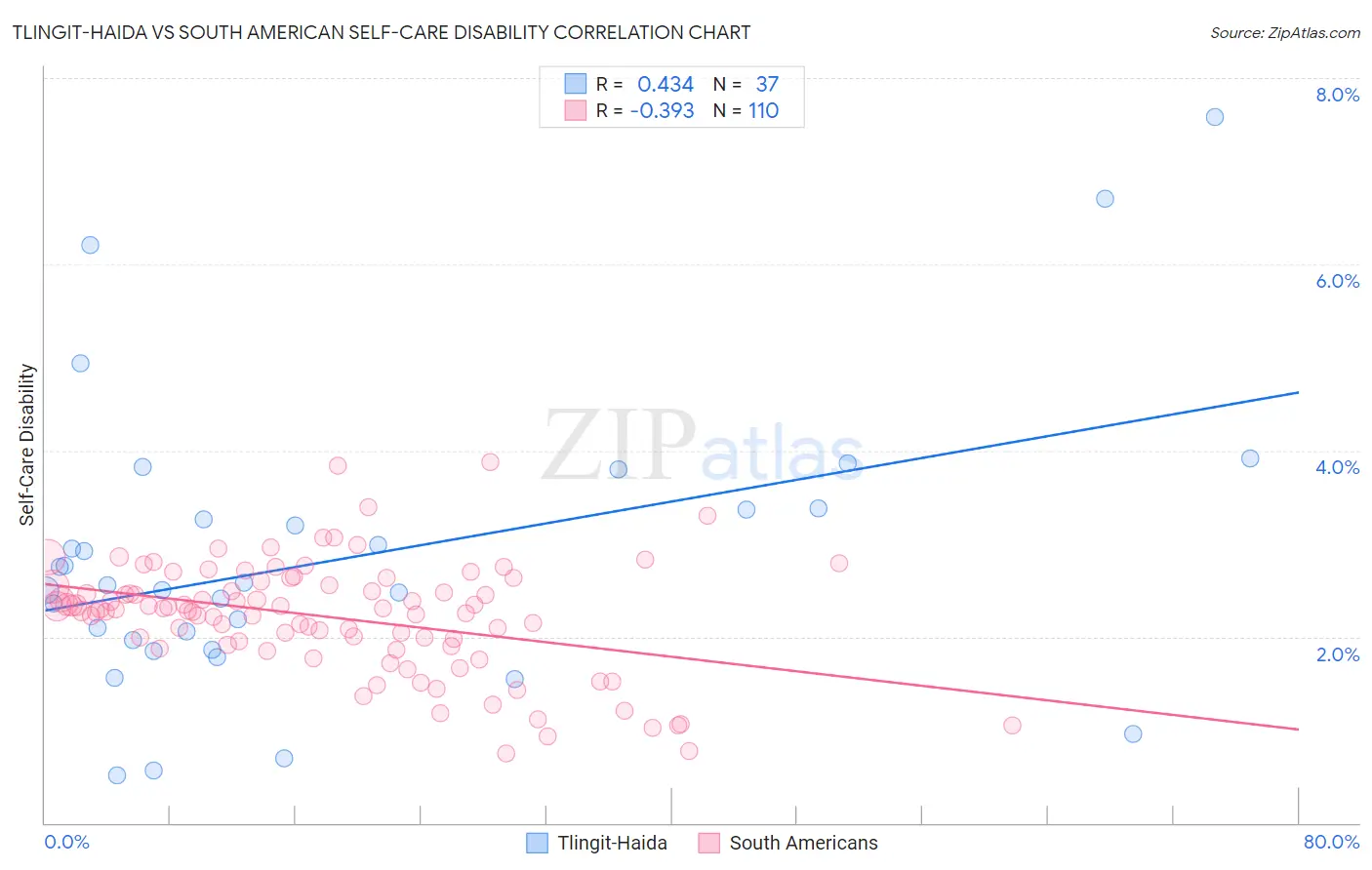Tlingit-Haida vs South American Self-Care Disability
COMPARE
Tlingit-Haida
South American
Self-Care Disability
Self-Care Disability Comparison
Tlingit-Haida
South Americans
2.4%
SELF-CARE DISABILITY
73.5/ 100
METRIC RATING
152nd/ 347
METRIC RANK
2.4%
SELF-CARE DISABILITY
93.2/ 100
METRIC RATING
113th/ 347
METRIC RANK
Tlingit-Haida vs South American Self-Care Disability Correlation Chart
The statistical analysis conducted on geographies consisting of 60,819,525 people shows a moderate positive correlation between the proportion of Tlingit-Haida and percentage of population with self-care disability in the United States with a correlation coefficient (R) of 0.434 and weighted average of 2.4%. Similarly, the statistical analysis conducted on geographies consisting of 493,131,874 people shows a mild negative correlation between the proportion of South Americans and percentage of population with self-care disability in the United States with a correlation coefficient (R) of -0.393 and weighted average of 2.4%, a difference of 1.9%.

Self-Care Disability Correlation Summary
| Measurement | Tlingit-Haida | South American |
| Minimum | 0.50% | 0.74% |
| Maximum | 7.6% | 3.9% |
| Range | 7.1% | 3.1% |
| Mean | 2.8% | 2.2% |
| Median | 2.6% | 2.3% |
| Interquartile 25% (IQ1) | 1.9% | 1.9% |
| Interquartile 75% (IQ3) | 3.4% | 2.6% |
| Interquartile Range (IQR) | 1.5% | 0.65% |
| Standard Deviation (Sample) | 1.6% | 0.60% |
| Standard Deviation (Population) | 1.5% | 0.59% |
Similar Demographics by Self-Care Disability
Demographics Similar to Tlingit-Haida by Self-Care Disability
In terms of self-care disability, the demographic groups most similar to Tlingit-Haida are Immigrants from England (2.4%, a difference of 0.010%), Basque (2.4%, a difference of 0.030%), Italian (2.4%, a difference of 0.080%), Immigrants from Costa Rica (2.4%, a difference of 0.10%), and Pakistani (2.4%, a difference of 0.13%).
| Demographics | Rating | Rank | Self-Care Disability |
| Germans | 80.1 /100 | #145 | Excellent 2.4% |
| Israelis | 80.0 /100 | #146 | Good 2.4% |
| Dutch | 77.5 /100 | #147 | Good 2.4% |
| Romanians | 75.8 /100 | #148 | Good 2.4% |
| Arabs | 75.7 /100 | #149 | Good 2.4% |
| Immigrants | Costa Rica | 75.1 /100 | #150 | Good 2.4% |
| Basques | 74.0 /100 | #151 | Good 2.4% |
| Tlingit-Haida | 73.5 /100 | #152 | Good 2.4% |
| Immigrants | England | 73.5 /100 | #153 | Good 2.4% |
| Italians | 72.2 /100 | #154 | Good 2.4% |
| Pakistanis | 71.4 /100 | #155 | Good 2.4% |
| Nigerians | 70.6 /100 | #156 | Good 2.4% |
| Immigrants | Europe | 69.6 /100 | #157 | Good 2.4% |
| Immigrants | Western Europe | 68.6 /100 | #158 | Good 2.4% |
| Immigrants | Italy | 68.5 /100 | #159 | Good 2.4% |
Demographics Similar to South Americans by Self-Care Disability
In terms of self-care disability, the demographic groups most similar to South Americans are Immigrants from North Macedonia (2.4%, a difference of 0.0%), Immigrants from Hong Kong (2.4%, a difference of 0.010%), Scandinavian (2.4%, a difference of 0.060%), Northern European (2.4%, a difference of 0.060%), and Serbian (2.4%, a difference of 0.090%).
| Demographics | Rating | Rank | Self-Care Disability |
| Immigrants | Indonesia | 94.3 /100 | #106 | Exceptional 2.4% |
| British | 94.3 /100 | #107 | Exceptional 2.4% |
| Greeks | 94.1 /100 | #108 | Exceptional 2.4% |
| Slovenes | 94.1 /100 | #109 | Exceptional 2.4% |
| Immigrants | Africa | 93.7 /100 | #110 | Exceptional 2.4% |
| Serbians | 93.6 /100 | #111 | Exceptional 2.4% |
| Scandinavians | 93.5 /100 | #112 | Exceptional 2.4% |
| South Americans | 93.2 /100 | #113 | Exceptional 2.4% |
| Immigrants | North Macedonia | 93.1 /100 | #114 | Exceptional 2.4% |
| Immigrants | Hong Kong | 93.1 /100 | #115 | Exceptional 2.4% |
| Northern Europeans | 92.9 /100 | #116 | Exceptional 2.4% |
| Taiwanese | 92.5 /100 | #117 | Exceptional 2.4% |
| Immigrants | Canada | 92.0 /100 | #118 | Exceptional 2.4% |
| Immigrants | Sierra Leone | 91.8 /100 | #119 | Exceptional 2.4% |
| Uruguayans | 91.5 /100 | #120 | Exceptional 2.4% |